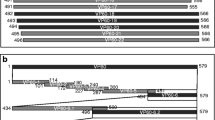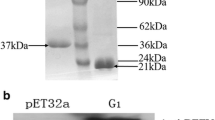Abstract
The epitope-G1 gene of Bovine ephemeral fever virus (BEFV) glycoprotein was synthesised by PCR and cloned into expression vector pPIC9K to construct recombinant plasmid pPIC9K-G1. Then the pPIC9K-G1 was linearized and transformed into Pichia pastoris GS115. The recombinant P. pastoris strains were selected by a G418 transformation screen and confirmed by PCR. After being induced with methanol, an expressed protein with 26 kDa molecular weight was obtained, which was much bigger than the predicted size (15.54 kDa). Deglycosylation analysis indicated the recombinant G1 was glycosylated. Western blot and ELISA tests, as well as rabbit immunization and specificity experiments indicated that the target protein had both higher reaction activity and higher immunocompetence and specificity. The recombinant G1 protein could be used as a coating antigen to develop an ELISA kit for bovine ephemeral fever diagnosis.
Similar content being viewed by others
References
Hsieh Y C, Chen S H, Chou C C, et al. 2005. Bovine ephemeral fever in Taiwan (2001–2002). J Vete Med Sci, 67: 411–416.
Hsieh Y C, Chen S H, Chou C S, et al. 2005. Development of a reliable assay protocol for identification of diseases(RAPID)-bioactive amplification with probing (BAP) for detection of bovine ephemeral fever virus. J Virol Methods, 129: 75–82.
Hsieh Y C, Wang S Y, Lee Y F, et al. 2006. DNA sequence analysis of glycoptotein G gene of bovine ephemeral fever virus and development of a double oil emulsion vaccine against bovine ephemeral fever. J Vete Med Sci, 68: 543–548.
Kongsuwan K, Cybinski D H, Cooper J, et al. 1998. Location of neutralizing epitopes on the G protein of bovine ephemeral fever rhabdovirus. J Gen Virol, 79: 2573–2581.
Stram Y, Kuznetzova L, Levin A, et al. 2005. A real-time RT-quantative(q)PCR for the detection of bovine ephemeral fever virus. J Virol Methods, 130: 1–6.
Walker P J. 2005. Bovine ephemeral fever in Australia and the world. Current Topics in Microbiol Immunol, 292: 57–80.
Yeruham I, Sharir B, Yadin H, et al. 2003. Bovine ephemeral fever in beef cattle herds in the Jordan Valley, Israel. Veter Rec, 152: 86–88.
Yin Z, Liu J H. 1997. Animal Virology. Second edition. Beijing: Science Press, 795–799. (in chinese)
Zakrzewski H, Cybinski D H, Walker P J. 1992. A blocking ELISA for the detection of specific antibodies to bovine ephemeral fever virus. J Immunol Methods, 151: 287–289.
Author information
Authors and Affiliations
Corresponding author
Additional information
Foundation item: National Dairy Foundation of China (2002BA518A04)
Rights and permissions
About this article
Cite this article
Zheng, Fy., Lin, Gz., Qiu, Cq. et al. Expression and antigenic characterization of the epitope-G1 of the Bovine ephemeral fever virus glycoprotein in Pichia pastoris . Virol. Sin. 22, 347–352 (2007). https://doi.org/10.1007/s12250-007-0031-2
Received:
Accepted:
Published:
Issue Date:
DOI: https://doi.org/10.1007/s12250-007-0031-2




